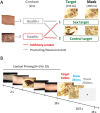Inhibitory framing in hypersexual patients with Parkinson's disease. An fMRI pilot study
- PMID: 35763033
- PMCID: PMC9288360
- DOI: 10.1007/s00221-022-06397-5
Inhibitory framing in hypersexual patients with Parkinson's disease. An fMRI pilot study
Abstract
Hypersexuality in medicated patients with PD is caused by an increased influence of motivational drive areas and a decreased influence of inhibitory control areas due to dopaminergic medication. In this pilot study, we test a newly developed paradigm investigating the influence of dopaminergic medication on brain activation elicited by sexual pictures with and without inhibitory contextual framing. Twenty PD patients with and without hypersexuality were examined with fMRI either OFF or ON standardized dopaminergic medication. The paradigm consisted of a priming phase where either a neutral context or an inhibitory context was presented. This priming phase was either followed by a sexual or a neutral target. Sexual, compared to neutral pictures resulted in a BOLD activation of various brain regions implicated in sexual processing. Hypersexual PD patients showed increased activity compared to PD controls in these regions. There was no relevant effect of medication between the two groups. The inhibitory context elicited less activation in inhibition-related areas in hypersexual PD, but had no influence on the perception of sexual cues. The paradigm partially worked: reactivity of motivational brain areas to sexual cues was increased in hypersexual PD and inhibitory contextual framing lead to decreased activation of inhibitory control areas in PD. We could not find a medication effect and the length of the inhibitory stimulus was not optimal to suppress reactivity to sexual cues. Our data provide new insights into the mechanisms of hypersexuality and warrant a replication with a greater cohort and an optimized stimulus length in the future.
Keywords: Addiction; Dopamine; Functional MRI; Impulse control.
© 2022. The Author(s).
Conflict of interest statement
The authors declare no conflict of interest for this study.
Figures


References
-
- Abler B, Kessler H. Emotion regulation questionnaire—eine deutschsprachige Fassung des ERQ von Gross und John. Diagnostica. 2009;55:144–152. doi: 10.1026/0012-1924.55.3.144. - DOI
-
- Berth H, Cloninger R, Przybeck T, et al. Das Temperament und Charakter-Inventar (TCI) Diagnostica. 2001;47:51–53. doi: 10.1026//0012-1924.47.1.51. - DOI
MeSH terms
Substances
Grants and funding
LinkOut - more resources
Full Text Sources
Medical
Miscellaneous

